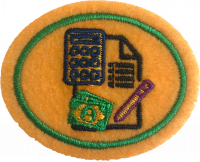Difference between revisions of "AY Honors/Household Budgeting/Requirements/es"
(Created page with "</noinclude>¿Qué métodos usa su familia para pagar las facturas? ¿Qué otros métodos podrían usarse? <noinclude>") |
|||
| Line 57: | Line 57: | ||
<noinclude></noinclude><section end=req5 /></b> | <noinclude></noinclude><section end=req5 /></b> | ||
| − | <b>6. <section begin=req6 /><noinclude></noinclude>¿Qué métodos usa su familia para pagar las | + | <b>6. <section begin=req6 /><noinclude></noinclude>¿Qué métodos usa su familia para pagar las cuentas? ¿Qué otros métodos podrían usarse? |
<noinclude></noinclude><section end=req6 /></b> | <noinclude></noinclude><section end=req6 /></b> | ||
Revision as of 21:38, 8 March 2023
Nivel de destreza
2
Año
2023
Version
02.01.2026
Autoridad de aprobación
División Norteamericana
1. ¿Qué es un presupuesto familiar y cuál es la importancia de hacerlo?
2. Definir lo siguiente:
- a. Ingresos
- b. Gastos
- c. Flujo de caja
- d. Préstamo
- e. Préstamo de usura
- f. Interés
- h. Principal
- h. Crédito
- i. Puntuación de crédito
- j. Inversiones
- k. Diezmos/ofrendas
- l. Impuestos
- m. Inflación
3. Explicar la diferencia entre necesidades y deseos. Hacer una lista de los gastos de su familia y clasificarlos como necesidades o deseos.
4. ¿Qué pueden hacer usted y su familia para ahorrar en los servicios públicos? ¿Cómo varía alguno de estos gastos durante las diferentes estaciones del año en su hogar?
5. ¿Cómo puede afectar la inflación al presupuesto familiar?
6. ¿Qué métodos usa su familia para pagar las cuentas? ¿Qué otros métodos podrían usarse?
7.What types of taxes exist in your area (city, state/provincial, federal, income, property, sales, payroll, etc.)? What are taxes typically used for in your region?
Explain the difference between good and bad debt.
What is interest? How is it calculated? Calculate how much it would truly cost to finance a $5000 loan with a 7% interest rate over 5 years.
Investigate what is the interest rate and what are the financial responsibilities in the lines of credit for the following:
- a.
Credit card
- b.
Overdraft
- c.
Student loan
- d.
Usury loan
11.
What measures can be taken when the family is in debt?
12.
Consider Proverbs 6:6-8 and discuss the value of having an emergency fund. How many months worth of income should generally be saved for emergencies?
13.
Read Matthew 25:14-30 and discuss the value of investing money. Identify at least two methods of investing money. What are the advantages and disadvantages of each?
14.
What are some advantages and disadvantages of using automatic payments (autopay)?
15. Mantener un presupuesto personal y registro de entrada y salida de dinero durante sies meses.
- a.
Identify an account and routing number
- b.
Write and endorse a check
- c.
Reconcile a bank statement
16.
Interview a financial professional or equivalent about personal budgeting.
17.
Develop a family budget (this can be done together with parents). Keep a personal budget and record income and expenses for two months.
18.
Read Malachi 3:8-12 and discuss what role tithes and offerings could play in a personal/family budget.


